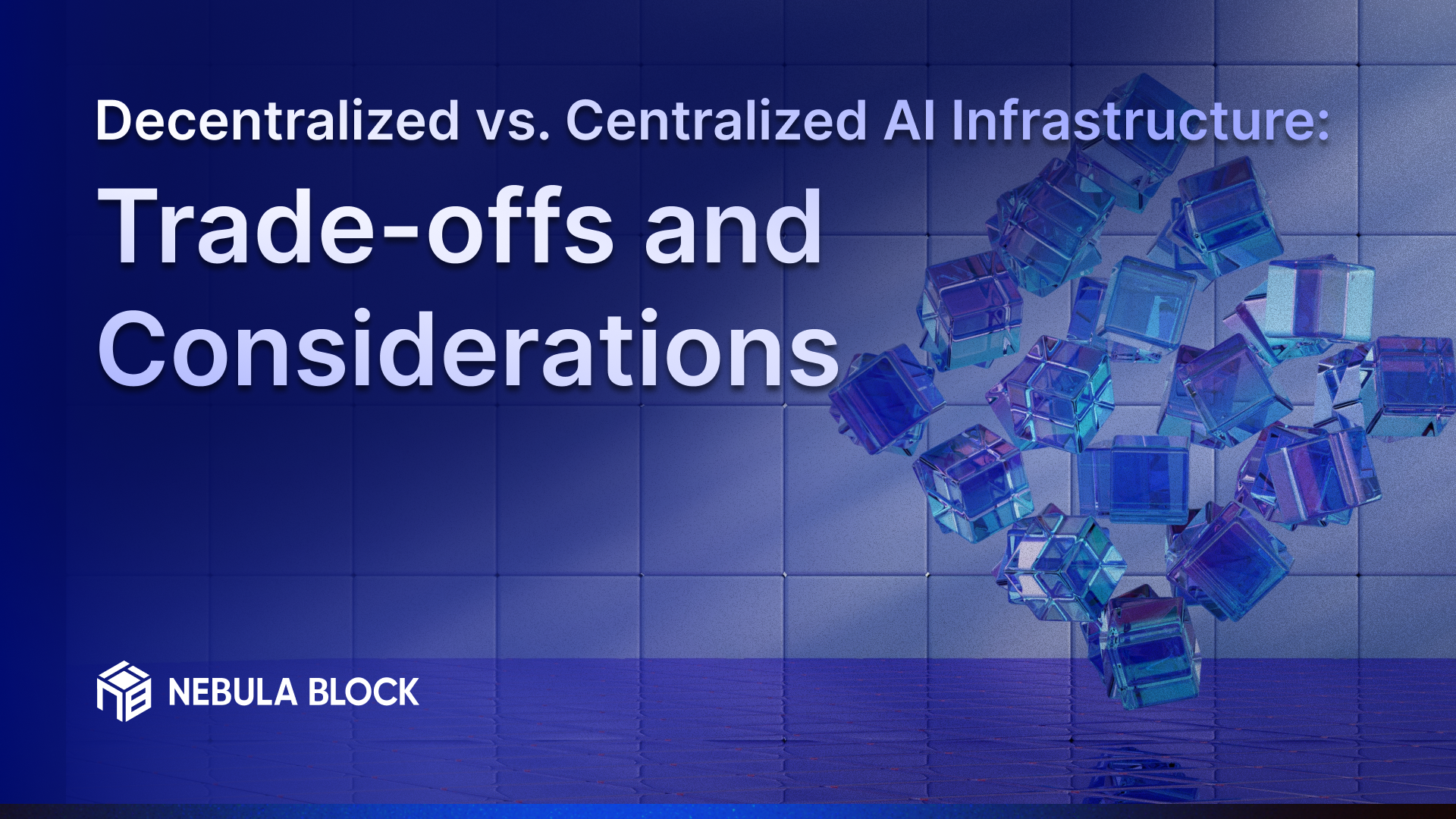Decentralized vs. Centralized AI Infrastructure: Trade-offs and Considerations

As AI systems scale, choosing the right infrastructure—centralized or decentralized—significantly impacts efficiency, security, and adaptability. While centralized architectures dominate enterprise AI workloads, decentralized AI is gaining traction for its privacy benefits and fault tolerance. This article explores key trade-offs and how Nebula Block’s flexible AI platform bridges these approaches.
Centralized AI Infrastructure: Stability & Scalability
Centralized models, like AWS or Nebula Block’s serverless GPU clusters, run workloads within unified cloud environments—ideal for enterprises requiring speed, scale, and simplified management.
✅ Advantages:
- Scalable GPU Power: Large-scale GPU clusters (e.g., NVIDIA H200/H100) enhance model training and inference efficiency.
- Seamless Integration: Centralized platforms provide API-driven resource allocation, reducing deployment complexity.
- Performance and Latency: Centralized systems optimize for low-latency tasks.
- Ease of Use: Users access pre-configured GPUs (e.g., H100/H200) via APIs, reducing setup complexity.
- Data Consistency & Compliance: Enables strict governance in regulated industries like healthcare and finance.
🧱 Challenges:
- Single Point of Failure – Outages can disrupt AI applications.
- Privacy Risks – Centralized storage raises concerns about data exposure and access control.
- High Latency – Remote processing in centralized clouds can slow real-time inference.
- Cost: While Nebula Block offers 30%+ cost savings, large-scale centralized infrastructure can be expensive for sustained high-demand workloads.
Decentralized AI Infrastructure: Flexibility & Security
Decentralized AI distributes workloads across edge nodes, blockchain networks, or federated systems, reducing reliance on a central authority.
✅ Advantages:
- Enhanced Data Privacy: Localized data processing , users retain control over data, addressing privacy concerns in healthcare or finance.
- Lower Latency: Edge computing accelerates real-time AI applications like autonomous systems.
- Greater Resilience: Distributed systems avoid single points of failure, enhancing reliability for global applications.
- Community-Driven Efficiency: Decentralized platforms incentivize node participation, potentially reducing costs through shared resources.
🧱 Challenges:
- Complexity: Managing distributed nodes increases setup and maintenance overhead.
- Latency: Decentralized systems often face higher latency due to network coordination
- Data Fragmentation – Ensuring consistency across decentralized models requires advanced coordination.
- Performance Variability: Heterogeneous node hardware leads to inconsistent performance
- Limited Governance – AI ethics and regulation enforcement are harder without a central authority.
Trade-offs and Considerations
- Latency vs. Resilience: Centralized mode achieves sub-100ms latency for real-time tasks, while its decentralized mode prioritizes resilience but may have higher latency.
- Cost vs. Privacy: Centralized mode offers cost savings but less data control; decentralized mode enhances privacy at the cost of operational complexity.
- Scalability vs. Flexibility: Centralized systems scale effortlessly, while decentralized systems offer flexibility for privacy-focused applications.
Nebula Block: Infrastructure for Both Centralized and Decentralized AI
Nebula Block delivers a flexible AI infrastructure platform that supports both centralized and decentralized workloads, empowering users to choose the best deployment model for their needs. From large-scale LLM inference to decentralized compute and real-time analytics, Nebula Block adapts to varied performance, privacy, and cost requirements.
With serverless GPU orchestration and Kubernetes-based resource scaling across 100+ global data centers, it dynamically allocates compute for use cases including AI inference, blockchain analytics, and simulation workloads.
Key Advantages
- Low-Latency Inference: High-performance LLMs, semantic search, and RAG pipelines powered by NVIDIA GPUs.
- 30-70% Cost Savings: More affordable than traditional cloud providers, optimized for AI compute.
- Scalable Resource Allocation: Kubernetes-driven flexible scaling to match AI workload demands.
- Flexible Infrastructure: Supports both centralized and decentralized AI workflows based on performance, privacy, and cost needs.
Decentralized AI & Partnerships
Nebula Block provides flexible infrastructure that supports both centralized and decentralized AI deployments—adapting to user needs for performance, cost, and data privacy. In decentralized mode, Nebula Block collaborates with Swan Chain, Fluence, Privasea, GAIB, and others to strengthen data privacy and enable secure, distributed AI processing.
Conclusion
Organizations must weigh security, latency, cost, and governance when selecting AI infrastructure. While centralized AI powers today’s high-throughput systems, decentralized AI unlocks the next wave of privacy-first and censorship-resistant applications. Whether optimizing for speed or privacy, Nebula Block gives users the infrastructure flexibility to choose the right AI path.
Next Steps
Sign up and explore now.
🔍 Learn more: Visit our blog and documents for more insights or schedule a demo to optimize your search solutions.
📬 Get in touch: Join our Discord community for help or Contact Us.
Stay Connected
💻 Website: nebulablock.com
📖 Docs: docs.nebulablock.com
🐦 Twitter: @nebulablockdata
🐙 GitHub: Nebula-Block-Data
🎮 Discord: Join our Discord
✍️ Blog: Read our Blog
📚 Medium: Follow on Medium
🔗 LinkedIn: Connect on LinkedIn
▶️ YouTube: Subscribe on YouTube